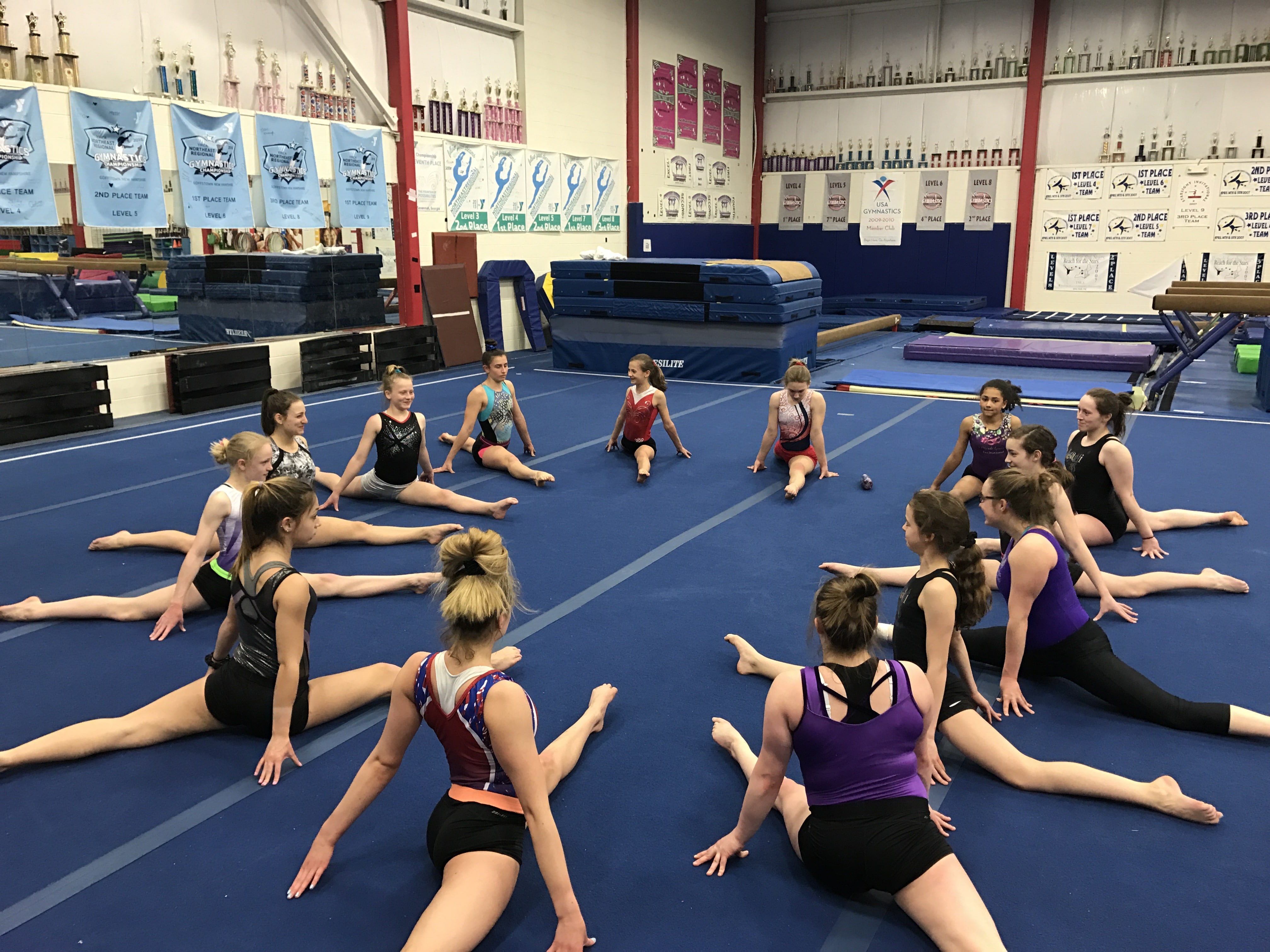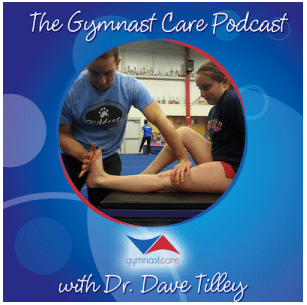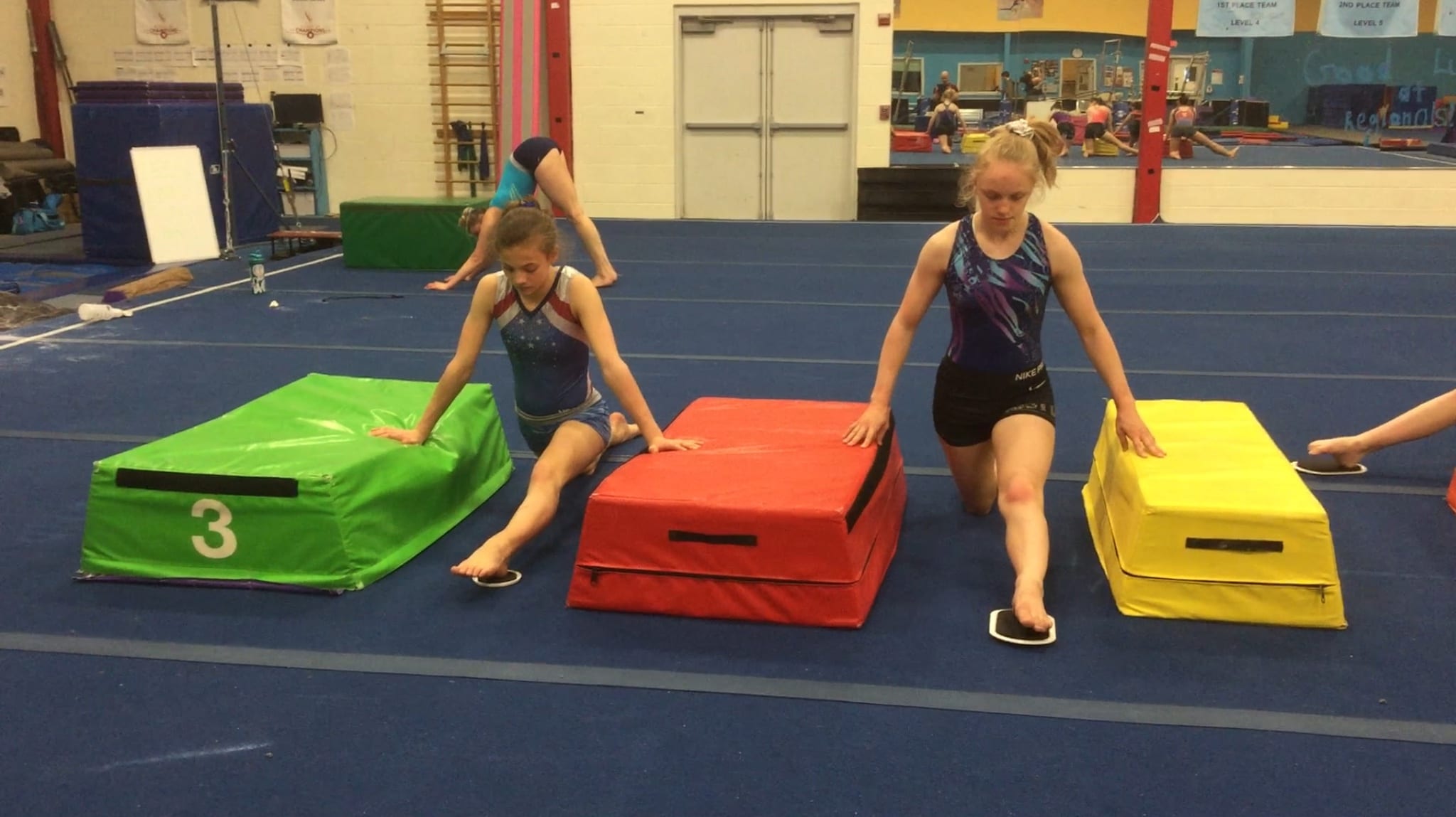10 Quick Tips – Safely Developing Hip Flexibility in Gymnasts
I’ve written some pretty in-depth articles on my thoughts related to hip flexibility research, injury mechanisms, and in gym methods, I think are useful. If you want to check them out, take a peek here, here, and here.
Also, if you want to know exactly what hip flexibility exercises, drills, and circuits I use with gymnasts, you can now get it all for free in my “10 Minute Gymnastics Flexibility Circuits” here,
Download My New Free
10 Minute Gymnastics Flexibility Circuits
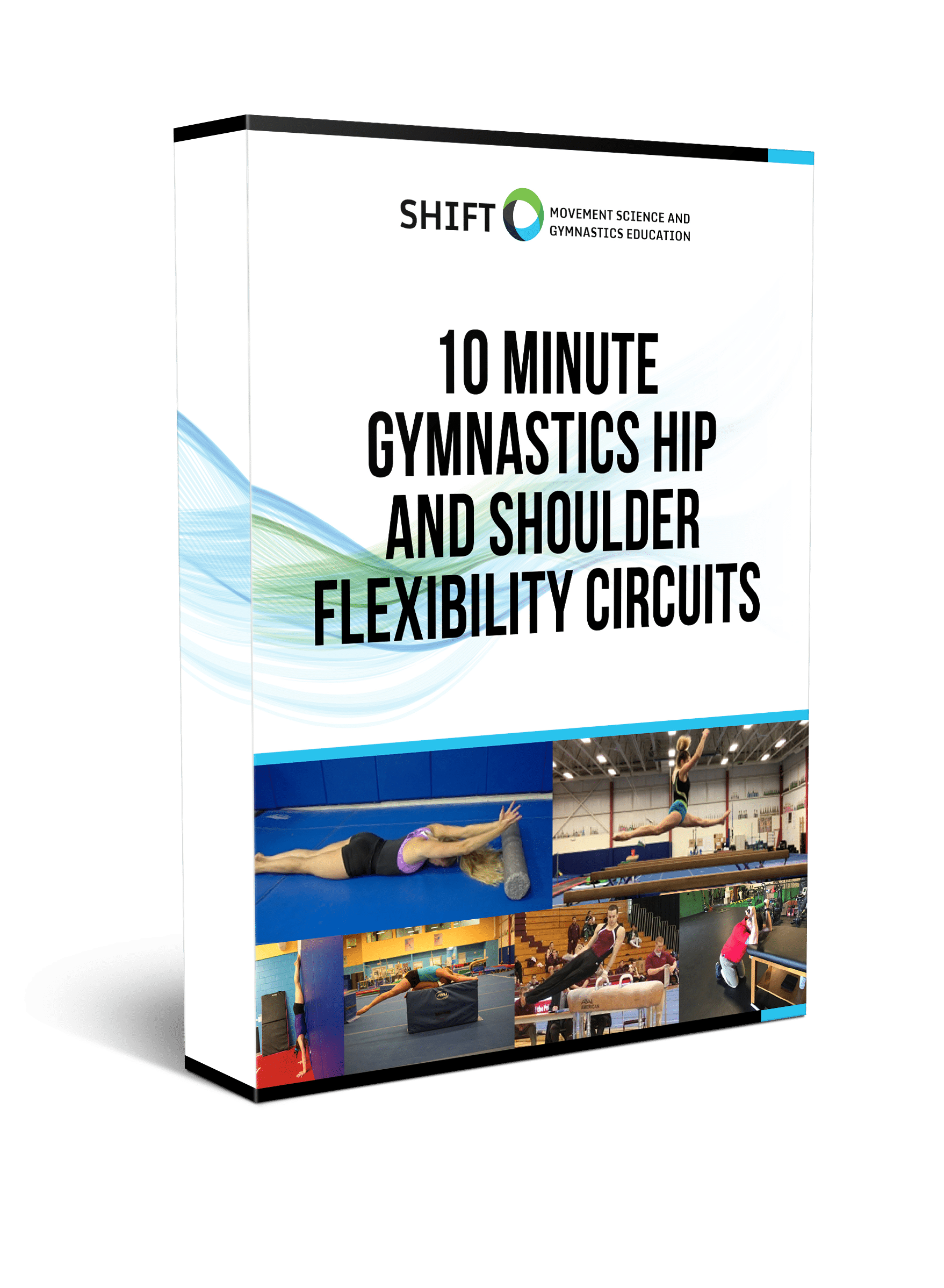
- 4 full hip and shoulder circuits in PDF
- Front splits, straddle splits, handstands and pommel horse/parallel bar flexibility
- Downloadable checklists to use at practice
- Exercise videos for every drill included
In this post, I wanted to do the opposite of super in depth. I wanted to offer my 10 biggest takeaway points from the last 5 years studying, treating, and working with gymnasts for hip flexibility related issues. This way, people can see the bird’s eye view, and dive into whichever area they find important.
Table of Contents
1. All Hips are Not The Same
- We have to realize no two gymnasts are the same. There is an insane amount of variability in the size and shape of hip joints, how shallow or deep hip sockets are, the length of leg bones, and more. The reason I mention this is not to say coaches must look at x-rays, but more importantly understand how important individual flexibility programs are. There will always be a general base of flexibility approaches to use in gymnastics, but we must tailor programs to each gymnast as needed, just like is done for skill training, routines, strength, and injury management.
- A huge pet peeve of mine is when someone sees a new split flexibility drill on social media or at a lecture, then just blindly applies it to their entire gymnastics team the next day. Don’t worry, it’s only become a pet peeve because I did it 100 times and had facepalm moments. Sure a few gymnasts may do great with it, but a for a large group of gymnasts with very different hip anatomy or flexibility levels, it could spark a huge injury to start. I think the best choice is to first think critically about what gymnast are most appropriate, what gymnast may need more specific flexibility drill, and what gymnasts maybe should see a healthcare provider for a screen first. Which leads to my next point.

2. Proper Movement Screenings and Assessments Are Most Critical
- Let me first say there are some amazing gymnastics coaches that have taught me fantastic hip flexibility drills I still use every week and recommend patients use when appropriate. With this being said, there are many coaches and gymnasts that would benefit substantially from uses medical providers screening skills. A knowledgeable medical provider has a skill set to really dial in on exactly why a gymnast is struggling with hip flexibility, leap angles, or lower body power.
- The range of contributing factors to limited hip flexibility can include unique boney anatomy, periods of rapid growth, soft tissue flexibility, muscle imbalances, limited full range control, fatigue, and more. I have worked with gymnasts who struggled for months before seeking a medical assessment. After a few weeks of exercises based on the assessment, they were able to huge changes in their passive and active hip flexibility, while having much less pain during the process. There is a caveat here though. As medical providers, we have to make sure we are using assessments that are very specific to gymnastics hip flexibility requirements.
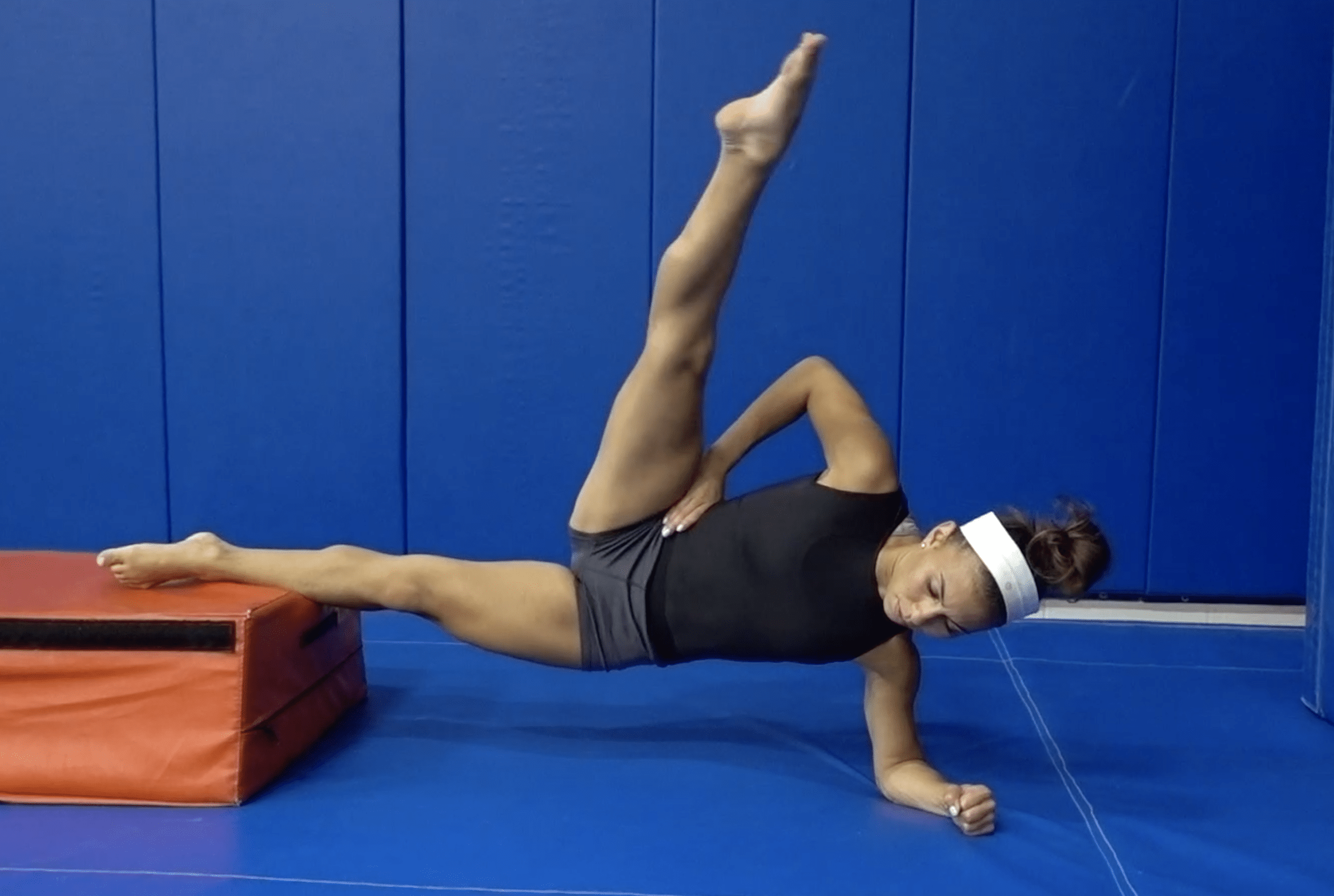
3. Focus on Managing Soft Tissue, and Not Stressing Ligaments / Joint Capsules
- The large proportion of gymnasts are already on the “loser jointed” half of the spectrum. Chances are they would not have progressed in gymnastics if they did not already have some degree of laxity, just like my chances of playing in the NBA are slim with my whopping 5’6 height. With this being said, we have to be very careful that the flexibility methods we use to spare the ligaments, capsules, and joints themselves from taking too much stress. If this happens, often times gymnast’s hips become too unstable with lacking strength/control, and pain or protective guarding can occur over time. Not to mention, instability based pain can start to occur and larger injuries may develop.

4. Teach Gymnasts to Manage Muscle Stiffness from Overuse in Training
- Building off of this, every sport has a natural adaptation that will occur over time due to its repetitive nature. Baseball players tend to lose overhead and lay back motions the more they throw, and runners tend to lose calf muscle flexibility if they run a lot and don’t keep up with maintenance care. The hips of gymnasts are prone to overuse and adaptive stiffness due to the nature of gymnastics form (legs together and straight) and repetitive jumping/running/leaping.
- For this reason, daily soft tissue care in the form of foam rolling / stick massage and muscle-specific targeting should be given to the inner thigh or groin, quads, hip flexors, and calves. Follow up isolated strength for the lateral core, glutes, and hip rotator muscles is also crucial. This helps maintain hip flexibility, reduce the risk of a gymnast acquiring a very over arched posture, and contributes to better skill performance. I have every gymnast I coach, rehab, or see for maintenance care do 10 minutes of soft tissue prep before practice to these areas. I think this along with proper technique, strength balance programming, and consistency flexibility drills can significantly help long-term hip flexibility.

5. Consistency is More Important Than Intensity
- Due to studying a lot of flexibility and hip injury research, I strongly feel that consistency is more important than intensity when it comes to hip flexibility in gymnastics. There are some interesting studies that outline how short-term hip flexibility gains may be more from neurological mechanisms than muscle tissue actually getting longer (read more interesting studies here, here, and here). Also, if you are curious about my thoughts on over splits, you can find a popular article I wrote about this topic here.
- Over time with a proper eccentric full range of motion strength and technique training, there can definitely be structural muscle changes in length. The take away that I use and teach is that finding a few flexibility drills you like, doing them consistently, and having a culture where gymnasts are fully dedicated to improving their flexibility (definitely doesn’t always happen working with teenagers) are way better approaches then pushing gymnasts down to the point of pain or killing them with 5 minute split holds. I used to be guilty of that, but have found much better methods now.

6. Use What You Gain Immediately
- It’s important that passive only flexibility methods are not the only approach. This is becoming more well known in the gymnastics community, but I still hear every week about gymnasts doing 20 minute flexibility rotations and then jumping right up on equipment for skills. It’s not that I feel some properly implemented passive stretching techniques are bad, its that in isolation they likely won’t stick around for long or show up in gymnastics skills. Doing active flexibility drills, strength work, drills, skill technique, and tracking how many skill numbers are done help solidify hip flexibility over time. I’ve written a bunch of articles on some of my favorite active hip flexibility drills you can find here and here.

7. Work in Performance Complexes, Not in Isolated Flexibility Training
- Tying this all together, I now use and teach people in gymnastics to use “Performance Complexes” (find more in this article here) instead of simply stretching for 20 minutes to see progress in hip flexibility. I created this term to summarize how I have been creating circuits that have a few steps in progression. It starts with baseline screening of splits on a line, then self-soft tissue massage then targeted stretching, then active flexibility or control exercises, then finishing with gymnastics – specific drills. If you want to read more about this, click here to check out an article and video I made a few years ago.

8. Know Warning Signs and Act On Them Immediately
- Unfortunately, I see a lot of hip issues being swept under the rug by the gymnastics community. Many parents, coaches, or gymnasts themselves are quick to say they just have a “hip flexor strain” or “pulled their hamstring” when in reality it’s an issue they have been trying to push through for a month and is really the start of a labral tear or growth plate stress fracture. Muscle soreness, tweaks, and various pulls are inevitable in gymnastics due to the demanding nature of training and the fact that gymnasts are almost always going through growth spurts. However, these small muscle strains resolve in a day or two with proper care and don’t tend to snowball into more pain each day.
- When these injuries start to creep up, they can drastically reduce hip flexibility, cause pain, take gymnasts out of training, and cause much bigger headaches. Be on the lookout for constantly sore hip flexors, groins, hamstrings, or pain developing with basic hip flexibility drills. I highly recommend that gyms have a culture of openness for the start of injuries that seem to be nagging. I also recommend that gymnasts/parents/coaches have a trusted network of doctors, rehabilitation specialists, strength coaches, nutritionists, or other professionals they can team up with.
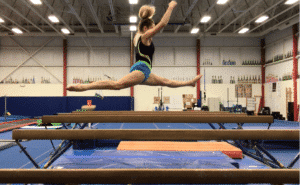
9. Know That Periods of Rapid Growth Naturally Reduce Flexibility
- When a gymnast goes through a rapid growth spurt, essentially the long bones of the legs and arms are where much of the length occurs. With this, almost always the muscles, tendons, and ligaments have trouble adapting to stretch at the same length. This often creates a short period of time when a gymnast appears to suddenly lose their flexibility, lose some strength/power, and struggles with gymnastics. There is usually one main period called the “Peak Height Velocity” when girls are aged 11 – 13 and boys 12 – 14. Unfortunately, it’s highly variable and differs to each athlete. Their chronological age (11 years old, 12 years old, etc) is not the same as their developmental age.
- For this reason, I suggest that all gymnasts track standing height, sitting height, and wingspan month to month to hopefully stay ahead of these times of rapid growth. We do this every month and keep a record of it, so we can see when arms or legs are growing rapidly. It often correlates to times of limited flexibility and general soreness, and as a result, we modify a young gymnasts training for a few weeks to hopefully not create bigger issues. It doesn’t always pan out exactly, but many times it makes a big difference. You can read more about this in an article I wrote last year.

10. Know What You Don’t Know
- I have made this mistake many, many times as a younger coach and medical provider. There is nothing worse than someone who knows a ton of information related to gymnastics technical, athlete development, physical preparation, and more trying to “dabble” in advanced hip flexibility or hip injury concepts. The worst thing you can do is try fake it instead of seeking out the guidance of someone who is more educated on the concept. If you are a medical provider who doesn’t fully understand gymnastics specific hip flexibility, grab coffee with a local gymnastics coaching staff to foster a relationship. If you are a coach who keeps seeing limited progress in hip flexibility or has athletes complaining of injury, seek out local medical providers to brainstorm ways to work together.
So, just like last week, I don’t want to go too crazy on information. I tried to include lots of relevant points and links to other articles for those more interested. For now, I hope this helps! Have a great week,
Dave Tilley DPT, SCS, CSCS
CEO/Founder of SHIFT Movement Science

